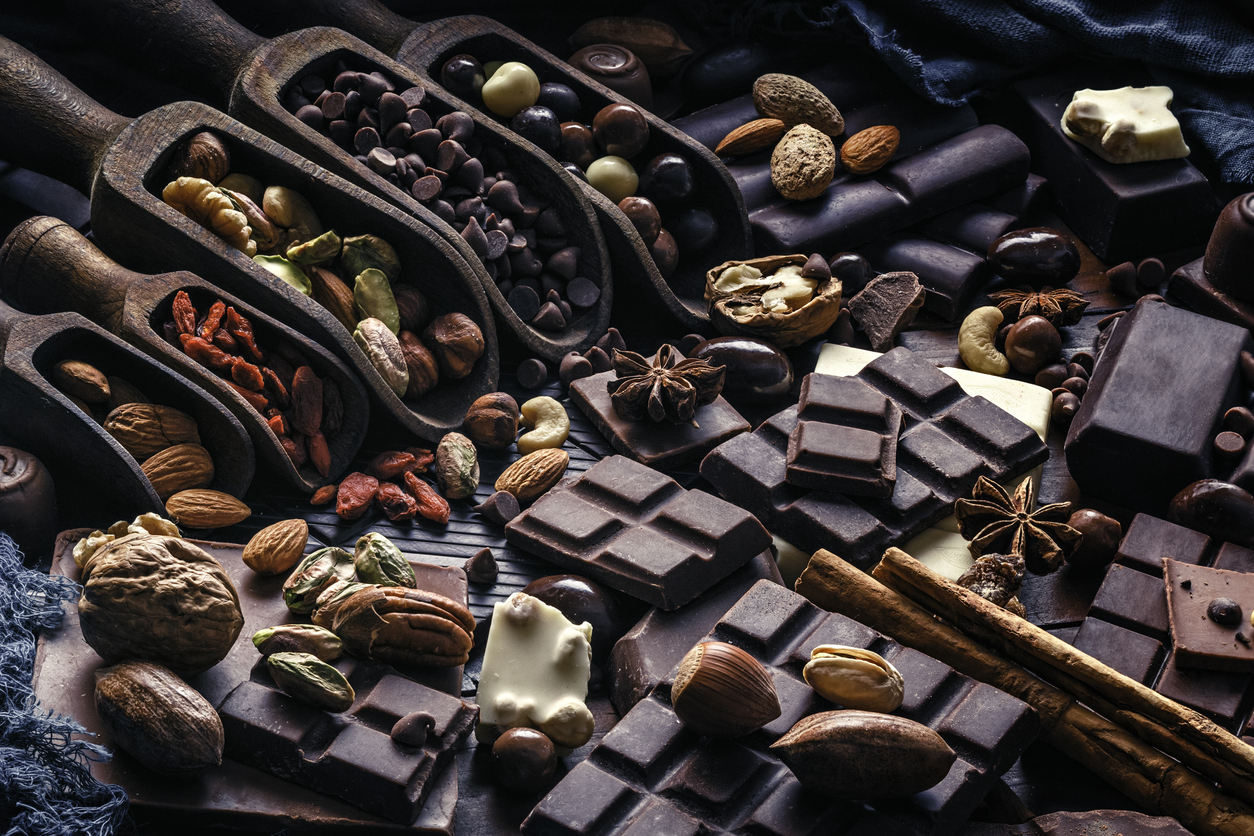Dr Des Corrigan looks at the origins, properties and composition of the chocolate products many of us will consume this Christmas
Over the many years that I have been writing this column, I have tried to make the December article seasonal in nature by highlighting, for example, the herbs, spices and poisonous plants in vogue at this time of year. It recently dawned on me that I had not yet written about a plant central to Christmas giving and enjoyment. After all, where would we be without chocolate Santas, snowmen and coins, not to mention the ubiquitous boxes of assorted chocolates, ranging from the mundane to the ultra-sophisticated Belgian pralines? The plant in question is Theobroma cacao, the seeds of which are the source of cocoa and chocolate in all its forms.
Human use of chocolate dates back to 1900 BC in Mexico, where both Mayans and Aztecs prized it in beverage form that they called chocolatl. Christopher Columbus is credited with introducing it to Spain, where the royal family pioneered its popularity and its use soon spread throughout Europe. Originally a South American plant, it is now mainly grown commercially in West Africa (Ivory Coast and Ghana), but also in Indonesia, Nigeria and Cameroon with small amounts from Brazil and Ecuador. When first harvested, the seeds are intensely bitter, so they are fermented to remove much of the bitterness and to develop the characteristic flavour. When roasted and powdered cocoa nibs are heated, they liquefy into chocolate liquor, which when cooled can be processed into cocoa solids and cocoa butter. Joseph Fry first mixed cocoa powder, sugar and cocoa butter, allowing him to mould the chocolate, leading to mass production of chocolate bars. The Swiss invented milk chocolate in 1875 leading to three main types, namely, dark (or bitter), white, and milk.
EU law regulates these three types in order to allow the free movement of chocolate products for human consumption throughout the Union by agreeing common definitions and rules for their composition, manufacturing and labelling. The Directive defines chocolate (ie, dark chocolate) as a mixture of cocoa solids and sugars that contains not less than 35 per cent dry cocoa solids, including a minimum of 18 per cent cocoa butter. White chocolate, on the other hand, contains no cocoa solids but must contain at least 20 per cent cocoa butter, a minimum of 14 per cent dry milk solids, as well as sugars. Milk chocolate in 26 EU countries must contain at least 25 per cent cocoa solids with not less than 14 per cent dry milk solids, to give a total fat content of no more than 25 per cent. The UK and Ireland are the exceptions to this requirement, as both were granted a derogation in the Directive that allows them to label as milk chocolate, material containing a different mix of cocoa and milk solids (a minimum of 20 per cent of each), reflecting market realities at the time the Directive was adopted.
Cocoa butter, also known as theobroma oil, is composed of solid (at room temperature) triglycerides of oleic, stearic and palmitic acids. A melting point between 34 and 38ºC makes it ideal for use in ointments, skincare products and of course suppositories. I am sure I am not the only one who has nightmarish memories of sweating (literally and metaphorically) over whether my suppositories would actually set during pharmaceutics lab classes. Apart from milk, no animal fats are permitted, but up to 5 per cent of vegetable fats are allowed, notably Borneo tallow, shea butter, kokum gurgi (sounds inviting, does it not?), but mostly palm oil which, as any eco-warrior will tell you, is now an environmental no-no!
Cocoa solids contain the xanthine alkaloids, predominantly theobromine (2-to-10 per cent), with much smaller amounts of caffeine and theophylline. The USDA Nutrient Database lists 28g of milk chocolate as containing 60mg of theobromine, compared to 200mg in the same weight of dark chocolate. Theobromine is a vasodilator, diuretic and cardiac stimulant, at doses in excess of those consumed in chocolate. It is not currently used in medicine but is of concern because of its toxicity to dogs, who metabolise it more slowly than humans do. A large dog can be poisoned by 400g of milk chocolate and a small dog by 50g, with the dark form being much more toxic. Last Christmas, my grandchildren discovered this for themselves when their four-year-old brother shared his chocolate Santa with their golden retriever puppy which had to be brought to the vet on St Stephen’s Day to have his stomach pumped out. A costly lesson for all, including the poor dog. Mind you, this same grandson has previous when it comes to chocolate at Christmas. Two years ago, after eating all his own and most of his sister’s chocolate “Brussels sprouts”, he was caught at the vegetable rack peeling a real sprout, leaf-by-leaf and was totally perplexed that there was no chocolate to be found.
Of the minor xanthines, theophylline is used in COPD and asthma, while caffeine is the most widely-used psychostimulant in all parts of the world and is on WHO’s List of Essential Medicines, being particularly valuable in respiratory conditions in the newborn. Cocoa is also a rich source of polyphenols, particularly flavanols or catechins, which are powerful antioxidants, the consumption of which could improve blood pressure, vascular tone, endothelial function and platelet reactivity, as well as insulin resistance and glucose tolerance. A 2015 paper in Vascular Pharmacology reported that high flavanol content dark chocolate conferred modest improvements in cardiovascular function. It had previously been shown that dark chocolate increased the level and bioavailability of vasodilatory nitric oxide, whereas milk chocolate significantly decreased its production. Most research papers highlight the potentially negative effect of the sugars and fat in milk chocolate. A review in the same journal noted that studies in both healthy and metabolically dysfunctional volunteers suggests that cocoa improves BP, platelet aggregation and endothelial function. The authors noted that the exact components responsible were still under debate but my attitude is, who cares, because it tastes fine as is. A Cochrane Review from 2017 did a meta-analysis of 35 trials involving 1,804 mainly healthy participants to reveal a small (2mmHg) but statistically significant reduction in BP when flavanol-rich cocoa products were compared to either flavanol-free or low flavanol products. This was contradicted by a Review of Reviews involving 13 systematic reviews and published in Phytotherapy Research that reported that BP was not reduced but that there was strong evidence that dark chocolate increased flow-mediated vasodilation, provided the cocoa product contained at least 100mg of catechin. They estimated that one would need to eat 50-to-200g of product to obtain that amount. There was also moderate evidence for improvements in blood glucose and lipid metabolism. More recent reports (2019) indicate beneficial effects on colonic function and a significant lowering of the odds of displaying clinically-relevant symptoms of depression based on data from over 13,000 adults.
Human nature being what it is, I suspect that none of the above is likely to impact on any of us who will raid the chocolate boxes over the festive season. Whether your choice is dark, white or milk, I hope you enjoy your selection and I wish you and your families a peaceful Christmas and a successful New Year.







